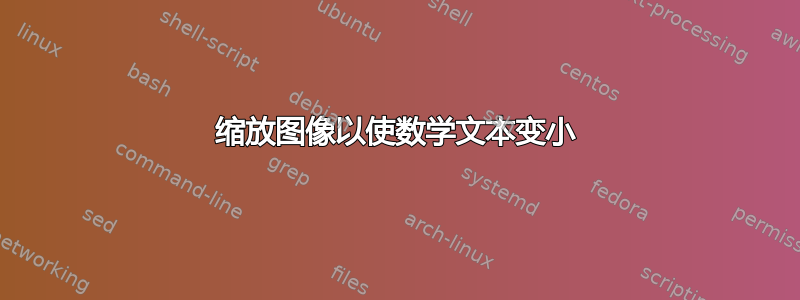
由于您无法设置数学符号的大小,我想知道我们是否可以将图像缩放得更大,以便数学看起来更小?
另外,我希望能够将子图的 x 轴和 y 轴更改为与样本图像相似?
最后,这可能很困难,但可以为与平均值和方差大致匹配的分布添加一些浅灰色的样本曲线/路径,并具有一些随机曲率,类似于下面的例子?
答案1
要增加图的大小,只需调整width高度即可。问题的第二部分我不明白。指示平均值和方差很简单。
\documentclass[tikz,border=3.14mm]{standalone}
\usepackage{pgfplots}
\pgfplotsset{compat=1.16}
\begin{document}
\pgfmathsetmacro{\offset}{0.05}
\begin{tikzpicture}[font=\sffamily,
declare function={gauss(\x,\y,\z)=\offset+1/(\y*sqrt(2*pi))*exp(-((\x-\z)^2)/(2*\y^2));}]
\begin{axis}[samples=101,smooth,hide axis,width=20cm,height=11cm]
\addplot [domain=-3:3] ({gauss(x,0.8,0)},x);
\addplot [domain=-3:3] ({1+gauss(x,1.2,0)},1+x);
\addplot [domain=-3:3] ({2+gauss(x,0.6,0)},x);
\foreach [count=\Y starting from 0] \vari/\DeltaX in {0.8/0,1.2/1,0.6/0}
{\typeout{\vari/\DeltaX}
\edef\temp{\noexpand\draw[gray] ({\Y+\offset},{\vari+\DeltaX}) -- ({\Y+gauss(\vari,\vari,0)},{\vari+\DeltaX})
({\Y+\offset},{-\vari+\DeltaX}) -- ({\Y+gauss(\vari,\vari,0)},{-\vari+\DeltaX})
(\Y+\offset,\DeltaX) -- ({\Y+gauss(0,\vari,0)},\DeltaX)
;}
\temp}
\draw[-latex] (0,-3) -- (0,3) coordinate[pos=0.4](x1) coordinate[pos=0.5] (y1)
node[below right,rotate=-90]{$x(t_i)$};
\draw[-latex] (0,-3) -- (0.5,-3) node[below left,rotate=-90]{$f\bigl(x(t_i)\bigr)$};
\draw (1,-2) -- (1,4) coordinate[pos=0.6](x2) coordinate[pos=0.5] (y2);
\draw (2,-3) -- (2,3) coordinate[pos=0.6](x3) coordinate[pos=0.5] (y3);
\addplot[-latex] coordinates{(-0.5,-4) (3,-4)};
\path (0,-4) coordinate (z1) (1,-4) coordinate (z2) (2,-4) coordinate (z3);
\coordinate (t) at (3,-4.1);
\coordinate (xi) at (-0.6,4);
\addplot[-latex] coordinates{(-0.5,-4) (3,-4)};
\addplot[-latex] coordinates{(-0.5,-4) (-0.5,4)};
\end{axis}
\foreach \X in {1,2,3}
{\fill (x\X) circle (2pt);
\draw ([xshift=-1mm]y\X) -- ([xshift=1mm]y\X);
\draw ([yshift=1mm]z\X) -- ([yshift=-1mm]z\X) node[below] {$\X$};}
\node[anchor=north east] at (t) {time};
\node[anchor=north east] at (xi) {$x(t)$};
\draw[blue,thick,shorten >=2mm,shorten <=2mm] (x1) -- (x2);
\draw[blue,thick,shorten >=2mm,shorten <=2mm] (x2) -- (x3);
\end{tikzpicture}
\end{document}
或者你也可以减小字体的大小。
\documentclass[tikz,border=3.14mm]{standalone}
\usepackage{pgfplots}
\pgfplotsset{compat=1.16}
\begin{document}
\pgfmathsetmacro{\offset}{0.05}
\begin{tikzpicture}[font=\sffamily\small,
declare function={gauss(\x,\y,\z)=\offset+1/(\y*sqrt(2*pi))*exp(-((\x-\z)^2)/(2*\y^2));}]
\begin{axis}[samples=101,smooth,hide axis,width=15cm,height=8cm]
\addplot [domain=-3:3] ({gauss(x,0.8,0)},x);
\addplot [domain=-3:3] ({1+gauss(x,1.2,0)},1+x);
\addplot [domain=-3:3] ({2+gauss(x,0.6,0)},x);
\foreach [count=\Y starting from 0] \vari/\DeltaX in {0.8/0,1.2/1,0.6/0}
{\edef\temp{\noexpand\draw[gray] ({\Y+\offset},{\vari+\DeltaX}) -- ({\Y+gauss(\vari,\vari,0)},{\vari+\DeltaX})
({\Y+\offset},{-\vari+\DeltaX}) -- ({\Y+gauss(\vari,\vari,0)},{-\vari+\DeltaX})
(\Y+\offset,\DeltaX) -- ({\Y+gauss(0,\vari,0)},\DeltaX)
;}
\temp}
\begin{scope}[thick]
\draw[-latex] (0,-3) -- (0,3) coordinate[pos=0.4](x1) coordinate[pos=0.5] (y1)
node[below right,rotate=-90]{$x(t_i)$};
\draw[-latex] (0,-3) -- (0.5,-3) node[below left,rotate=-90]{$f\bigl(x(t_i)\bigr)$};
\draw[-latex] (1,-2) -- (1,4) coordinate[pos=0.6](x2) coordinate[pos=0.5] (y2);
\draw[dashed] (0,-3) -- (0,-3.5);
\draw[-latex] (2,-3) -- (2,3) coordinate[pos=0.6](x3) coordinate[pos=0.5] (y3);
\draw[dashed] (1,-2) -- (1,-3.5);
\path (0,-4) coordinate (z1) (1,-4) coordinate (z2) (2,-4) coordinate (z3);
\draw[dashed] (2,-3) -- (2,-3.5);
\coordinate (t) at (3,-4.1);
\coordinate (xi) at (-0.6,4);
\addplot[-latex] coordinates{(-0.5,-3.5) (3,-3.5)};
\addplot[-latex] coordinates{(-0.5,-3.5) (-0.5,3.5)};
\end{scope}
\pgfplotsinvokeforeach{1,...,20}{
\draw[very thin] plot[smooth] coordinates
{(0,{sign(2*rand-1)*(exp(-rand/0.8)-1)})
(1,{1+sign(2*rand-1)*(exp(-rand/1.6)-1)})
(2,{sign(2*rand-1)*(exp(-rand/1.2)-1)})};}
\end{axis}
\foreach \X in {1,2,3}
{\fill (x\X) circle (2pt);
\draw ([xshift=-1mm]y\X) -- ([xshift=1mm]y\X);
\draw ([yshift=1mm]z\X) -- ([yshift=-1mm]z\X) node[below] {$\X$};}
\node[anchor=north east] at (t) {time};
\node[anchor=north east] at (xi) {$x(t)$};
\draw[blue,thick,shorten >=2mm,shorten <=2mm] (x1) -- (x2);
\draw[blue,thick,shorten >=2mm,shorten <=2mm] (x2) -- (x3);
\end{tikzpicture}
\end{document}





